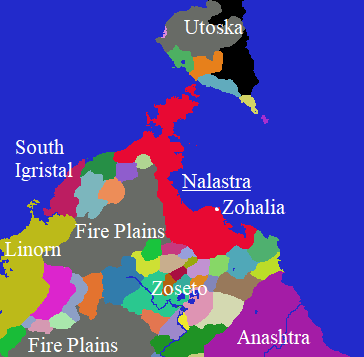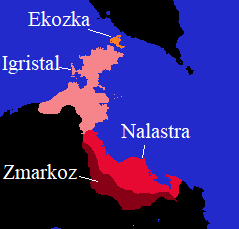Sacred State of Nalastra
Where some religious leaders only get a large institutionalized religious structure, the Sarakan Heirophant gets a prosperous mercantile empire as well. This is the Sacred State of Nalastra, physical embodiment of the Sarakan temple and supreme kingdom of the faithful. The Sacred State guards the holy sites, serves the church, and hosts the vast administrative and commercial bureaucracy of the Sarakan temple.
While the government always has an eye on this religious big picture, local culture and affairs are always at play as well. Nalastra is a prosperous land of miners, sailors, and merchants insulated from the Tolzel Fire Plains by mountains and fortresses. It is a world apart from the rest of Western Garadel, a pillar of stability, wealth, and artistic sophistication. The people here celebrate their faith more in color and boisterousness than in traditional ascetic reverence - being loud is not just considered to be normal, but to be a critical part of community participation. Everyone has a place and a voice as long as they are willing to demand it, that is the Nalastran way. Needless to say, there is a lot of friction between Nalastrans and the rest of Tolzel, which makes for quite the cultural balancing act for the religious elites.
Nalastra has recovered from a brief conquest by horse nomads some fifty-five years ago and is mostly concerned with keeping the current order stable and functional. Some remnants of that nomadic administration remain in place after all that time, but the reigning attitude is to ignore that the conquest ever happened. There is a kind of cultural amnesia and willing blindness going on: don't remember painful pasts, don't point out flaws in Sarakan religious unity, just focus on the Love of the Goddess Tira and the prosperous future that awaits.
Structure
Nalastra is ruled by the Hierophant of the Redeeming Flame, who is also the leader of the Sarakan faith. Each hierophant chooses a Exalted Regent to rule the land whenever they are occupied with religious business. Four Servant Princes selected by the Heirophant from local elites act as the governors of the four provinces:
- Nalastra, the coastal center of the sacred state, center of wealth and trade
- Zmarkoz, the mountainous, prism-filled region famous for its mining and defensiveness
- Igristal, the peninsular grasslands known for their feudal estates and large ranches
- Ekozka, a wealthy and densely populated island with a bold and colorful local culture
Culture
Culture of Consensus
Food and Styles
History
Early History
The Rise of Saraka (1450 to 1692 ME)
Sacred Nalastra (1692 to 1957)
Nalastra held onto Ekozka, but struggled to hold onto the actual peninsula of Igristal. The local lords were released as independent rulers, and Nalastra pivoted to focus on itself. The faith had its fair share of disputes to solve and challenges to overcome: there were lots of internal wars within Sarakan territory and mystery cults to integrate into the temple. For a century, Nalastra sat relatively still and prospered while it became synonymous with Sarakan religious leadership. The 1800s saw Nalastra throw its weight around a little as a state - the Sarakan temple was brought to bear to bring the kingdoms of Zoseto into Nalastra's economic and political sphere or influence, for example - but for the most part, it was still a time of peace and stability.
The discovery of a massive cache of Starmetal - much of it from one meteor, but with bits of other meteors from the deep sea placed around it - in a cavern on the coast of Igristal in 1939 changed everything. The Sarakan temple moved quickly to try and secure the Starmetal for the Heirophant, but the local kingdoms were moving just as fast. This much starmetal this close to the Dragon Forges was worth an emperor's fortune and could be transformed into truly magnificent magical artifacts. When the Heirophant heard that the local kingdoms were using bribery and soldiers to steal the Temple's "rightful" gift from the Gods, Nalastra sent an invading force in to secure the cache. From 1939 to 1945, Nalastra fought its way across Igristal. The starmetal secured, the new Heirophant set to overhauling the military; clearly, the lesser states of the continent no longer respected the power of the Sacred State, and were in need of some 'shows of strength'. Nalastra set to conquering lesser states, fighting off nomads, and otherwise flexing wherever possible.
Modern History
Demography and Population
Territories
Nalastra is composed of several regions: True Nalastra, along the Southeastern coast, the penninsula of Igristal, the mountainous interior region of Zmarkoz, and the Northern isle of Ekozka. A large number of islands sit off the coast.
True Nalastra is 385 miles long and extends 70 miles inland. It has a semi-arid climate, with golden hills and redwood forests. It is well insulated from both the Tolzel Fire Plains and the cold Western winds. The capital city of Zohalia is located here.
Zmarkoz is 300 miles long and 40 miles across. It is essentially a mountain range that has become populated enough with Prisms to be its own province. The Southern side is scorched by wildfires, and the North is the same highly habitable climate as True Nalastra.
Igristal is an occupied region 180 by 150 miles across. It becomes more mountainous the further North one goes, and the Northern peninsula filled with inlets, caves, islands, and turbulent lochs.
Ekozka is a lush island 8 miles North of Igristal. It is 45 miles long and 22 miles across. Ekozka is 12 miles South of the large island of Utozka, and sits right in the middle of Cape Hart - the straight that all ships traveling around Garadel must pass through.
Military
The pride of Nalastra is their navy. The current Heirophant has overhauled shipbuilding with foreign sailing technologies and weaponry, while keeping elements of traditional Nalastan naval warfare. A classic example of a traditional Nalastran naval weapon is the Firemine, a small balloon-like device filled with Fire Termite oil, primed to violently splatter ignited oil if the balloon is disturbed or popped. Dozens to hundreds of these tiny incendiary explosives can be deployed during a naval battle to destroy enemy vessels foolish enough to get close. In the strong currents and narrow straights of Igristal, mines can be lethal even for experienced selkie sailors, if they are unfamiliar with the area. As for Nalastra's actual ships, they prefer large numbers of fast, maneuverable, well-armed medium-to-small ships for their navy.
As for the land military, each province provides its own specialty: Nalastra proper provides archers, Zmarkoz provides spear-warriors and hammerers, and Igristal provides cavalry. Nalastra's armies seem to prefer defensive tactics and technologies - a staunch line of spears or halberds paired with expert archers and maybe some artillery and spellcasting is seen as the pinnacle of "smart" warfare. Dragon sorcerers are the main pillar of magical support here, though a number of Emesh paladins also serve the Heirophant. An elite guard group known as the Reborn Souls, who are believed to be reincarnated eternally in service of Tira, also serves as the Heirophants personal guards and halberdiers.
Religion
Nalastra is the Sarakan Temple. The legal and justice systems of Nalastra are run by the Temple, and advancement in the state bureaucracy often involved some participation in Sarakan religious events and communities. Sarakism is not mandatory, though - merchants are welcome to hold their own beliefs as long as they do not evangelize. Foreigners do have some religious protection in the form of the Rite of Understanding: the ability to invoke one's external religious rules as a reason for one's breaking of a law or taboo. If that law or taboo is non-violent and non-destructive, the charge is likely to be dropped, and if not it will have a greatly reduced sentence.
When it comes to mystery cults, virtually all of the big regional ones have some kind of presence here: the Cults of Holy Geometry (monastic mathematicians, artists, and archivists), Emeno the Laughing Sun (expert archers, sorcerers, and masters of Comedy Magic ), Nitren the Season Turner (scarified monks skilled with the Way of the Open Palm), Senikirol the Eternal King (monks who study stealth, precise movement, and swordplay), and The Circle of Wildfire (druid mystics). These are all in fairly small numbers, primarily linked to the ports, but their performances and spiritual power and widely respected. Nalastra has its own mystery cult: The Cult of Godrinar, the God of Justice, Preservation, and Protection in traditional Nalastran religion. Cultists of Godrinar cut themselves off from all worldly attachments and desires to become perfectly impartial, and act as judges, investigators, and lawyers.
Pilgrims flock from across Western Garadel to visit Nalastra's holy sites. The greatest of these are the capitol, the Holy City of Zohalia, and the Ember Cathedral of Ekozka (former headquarters of the Ember League repurposed as a grand temple to Tira).
Foreign Relations
Nalastra's foreign policy is deeply colored by religion, as it is closely bound to the leadership of the Temple of Saraka. It considers the Kingdom of Linorn an ally, and is on tentatively positive terms with the Riders of the Free Flame. The many kingdoms of Zoseto are economic and political thralls of Nalastra, and supply much-needed food, lumber, and textiles for the Nalastran economy.
Nalastra's relationship with the Kingdom of Anashtra is rather turbulent. Anashtra is a militaristic power that often ignores the commandments of the Heirophant, and the two states have clashed over control of Zoseto in the past. That said, the two have managed a working relationship when it comes to fighting Zihari states in the Southeast.
Nalastra has other working-but-contentious relationships with the Kingdom of Ezekos and the Kingdom of Senelon - two Sarakan regional powers that often see themselves as the masters of the faith.
Agriculture & Industry
Like most countries, Nalastra is majority agricultural. Wheat is the staple crop here for dryads and humans. Figs, almonds, apricots, olives, kiwis, walnuts, and avocados are also grown aplenty. Potatoes are common in the mountains. Olive oil, wine, and dairy products are significant industries here as well.
Nalastra is a center of industry, with robust guilds and trading ports; Zmarkoz is a major center for metal, salt, and mineral mining; Igristal is a mixture of ranching, Fire Termite and Dragomander farming; and Ekozka is a hub of trading and manufacturing.
Trade & Transport
Trade is managed by the Sarakan Temple; the guild of merchants is a sacred institution, and Sarakan faith is required for any who hope to avoid tariffs. Artisan guilds have church ties but are less directly religiously controlled.
Education
Most education in Saraka is managed by temple schools. Advanced education is handled by hyper-specialized academies run by the state. Rather than having educators of all disciplines gathered in general universities, Nalastra's academies expect elite academics to cycle through multiple academies according to their needs and expected role.
In Service of Tira
Founding Date
1963
Type
Geopolitical, Theocracy
Demonym
Nalastran
Leader
Government System
Theocracy
Power Structure
Feudal state
Currency
Garadek Gold Moons, Silver Suns, Copper Stars
Major Exports
Stone, salt, Prism-food, metals, Fire Termite oil, olive oil, wine
Major Imports
Silk, lumber, textiles
Judicial Body
The Scouring Court
Official State Religion
Location
Neighboring Nations
Related Plots
Remove these ads. Join the Worldbuilders Guild





Comments